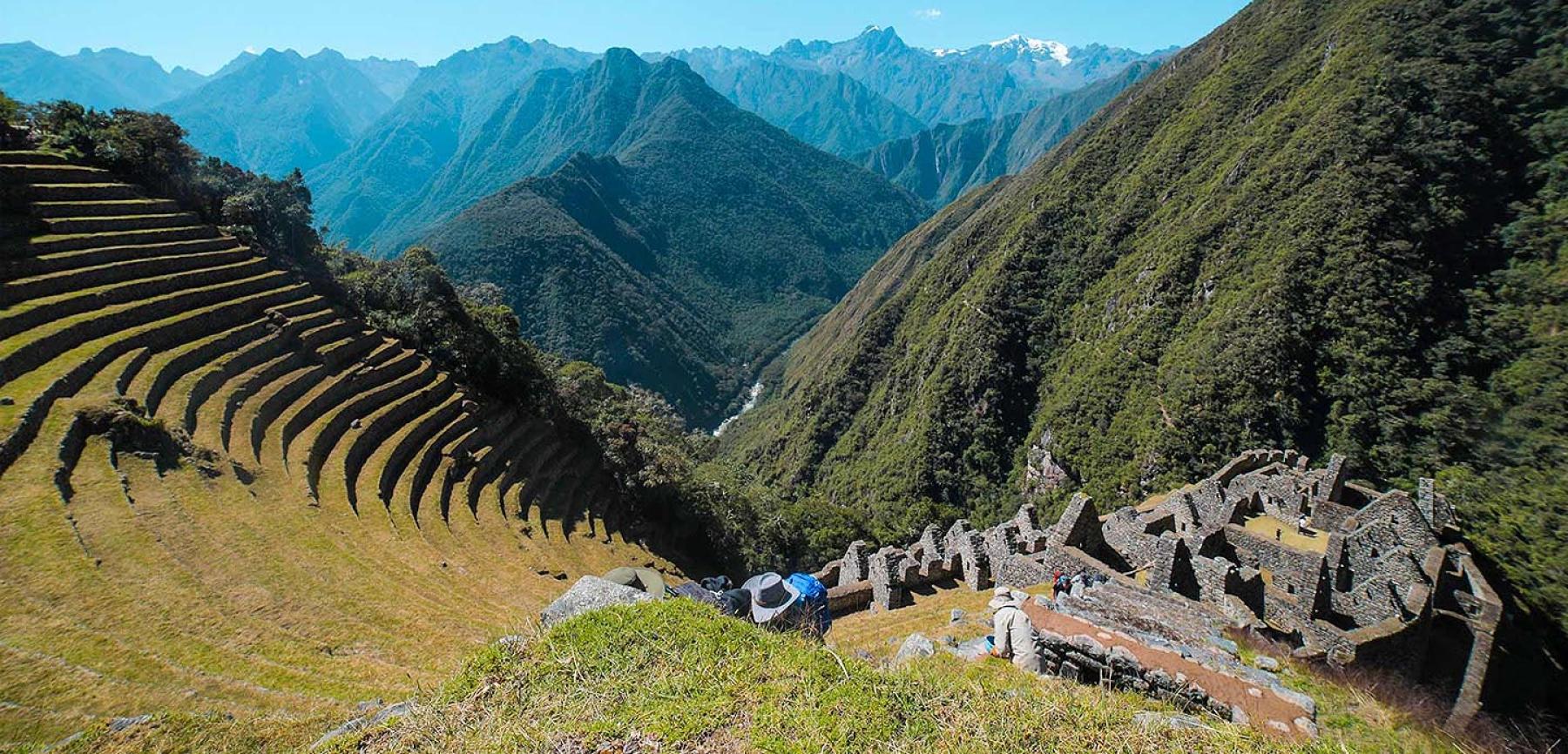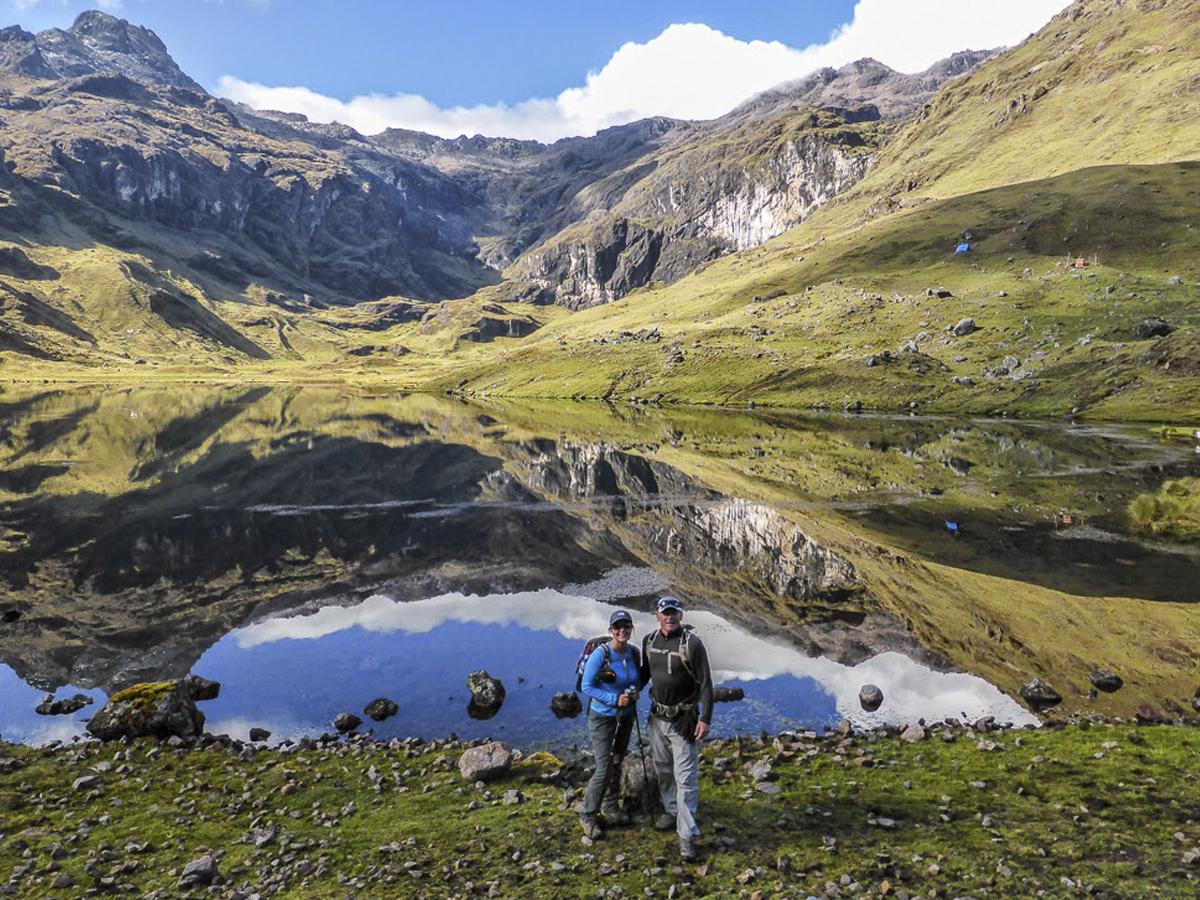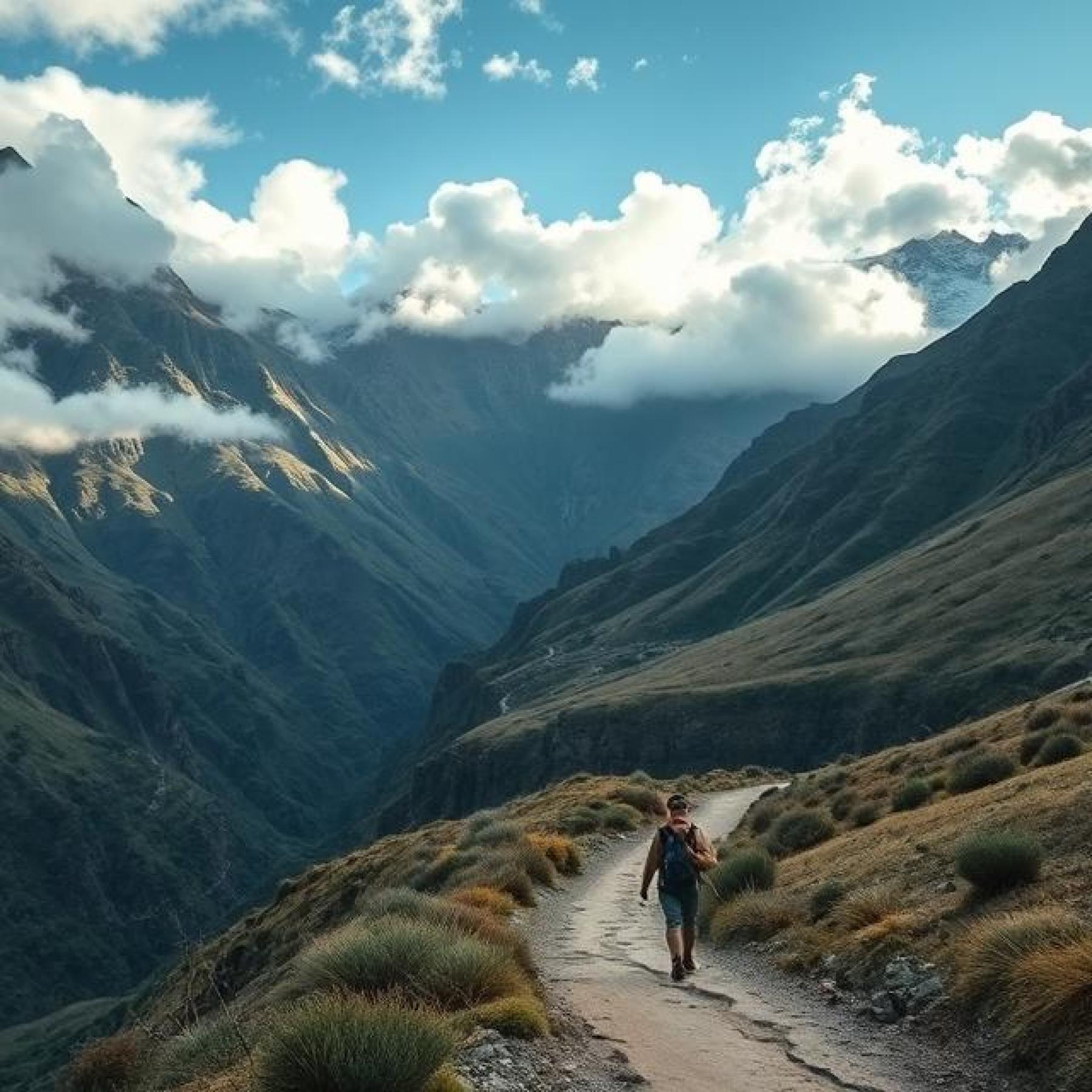Inca Trail

The Inca Trail to Machu Picchu is one of the most iconic hikes in South America, and frequently ranked among the top 5 trekking routes in the world – what an achievement! This incredible Machu Picchu trek is a perfect blend of natural beauty, archaeological wonders, and cultural significance, and we just know it's going to be a life-changing adventure for you!
The classic Inca Trail is a 26-mile (43-kilometre) journey that will take you through the heart of the Sacred Valley of the Incas. As you journey through the beautiful landscapes of the Andes, you'll be amazed by the lush cloud forests, the tropical jungles, and the incredible mix of ancient Inca paving stones, ruins, and tunnels. And the journey culminates at the breathtaking Machu Picchu, often called the Lost City of the Incas—a UNESCO World Heritage Site and one of the New Seven Wonders of the World.
The Inca Empire was a really special place, and more than 500 years ago they built an amazingly advanced system of roads. These roads were almost 40,000 kilometres long and connected major cities and remote settlements across a huge territory stretching from Quito in Ecuador to Santiago in Chile, and eastward to Mendoza in Argentina. Right at the heart of this mighty empire was Cusco, the ancient capital of the Incas.
While many of these historic trails still exist, the 43-kilometre section that connects Runkurakay, Sayacmarca, Phuyupatamarca, Wiñay Wayna, and finally Machu Picchu has become the most famous – and with good reason! For over 30 years, this beautiful hiking trail has been a magnet for thousands of trekkers each year, all seeking to follow in the footsteps of the ancient Incas.
Due to its popularity and environmental sensitivity, access to the Inca Trail is strictly regulated by the Peruvian government. Only authorized trekking companies can offer guided hikes along this route. Each day, just 500 permits are issued—including those for tourists, guides, porters, and cooks—leaving room for only 200 hikers per day. Booking your Inca Trail permit several months in advance is strongly recommended to secure your spot on this unforgettable journey.
Inca Trail Regulations – Preserving the Historic Sanctuary of Machu Picchu (HSM)
The Inca Trail Network, which forms part of the Historic Sanctuary of Machu Picchu (HSM), is subject to a protection and regulation regime that is in place to ensure its preservation. The Inca Trail system, which includes the entire trail and its officially authorised routes, has been recognised by UNESCO as a Cultural and Natural World Heritage Site.
Why Inca Trail Regulations Were Implemented
Between 1996 and 2001, the Inca Trail saw up to 1,500 people daily, including 1,000 tourists and 500 porters, particularly during the high season. At the time, there were no official rules in place. Hikers were permitted to camp wherever they wanted, used archaeological sites as toilets, and left trash along the trail. This has led to an escalating international concern, with UNESCO even threatening to revoke Machu Picchu's World Heritage status. In protecting the site, the Peruvian authorities implemented the Inca Trail Regulations in 2002, introducing strict guidelines to limit trail usage, ensure sustainable tourism, and preserve Inca heritage. During the high season (July and August), the Inca Trail saw up to 1,500 people per day. This figure included approximately 1,000 tourists and 500 porters.
Huayna Picchu Tickets and the Inca Trail
The Peruvian government has introduced a new regulation that affects how trekkers on the Inca Trail to Machu Picchu can access Huayna Picchu Mountain. If you want to hike the classic Inca Trail, please read this important update carefully before booking.
Inca Trail Tickets Do Not Include Huayna Picchu Access
Due to this new rule, Inca Trail permits come with a special entry ticket to Machu Picchu, which does not allow the addition of a Huayna Picchu pass. Only those who purchase a general Machu Picchu entrance ticket can add the Huayna Picchu hike.
When you complete the Inca Trail, you will be among the only visitors who enter Machu Picchu through the Sun Gate (Inti Punku)—a truly unique and exclusive experience that differs from the general public entrance. From here, you'll receive a dedicated guided tour of Machu Picchu, starting at sunrise, which is a highlight of the entire trek.
Want to Climb Huayna Picchu?
If you want to go up Huayna Picchu, you'll need to buy a separate ticket to enter Machu Picchu (this costs about USD $60 per person). Remember:
- Your group might have to cut short the guided tour of Machu Picchu to meet the entry time for Huayna Picchu (especially for the second entrance group).
- There are only a few of these available, and you have to book well in advance.
- We don't think you should climb Huayna Picchu as part of your Inca Trail trip unless it's something you really want to do.
Recommendation:
Unless you really want to go to Huayna Picchu, we suggest focusing on the Inca Trail experience. Enjoy your special entrance through Sun Gate and the guided tour of Machu Picchu without rushing.
Inca Trail Booking
Inca Trail permit availability
Since only 500 trek permits are issued per day for the Inca Trail tours (trek permits are also required for the porters and cooks) it is important to try to make a trek reservation as far ahead as possible. There is no clear rule as to how far ahead is enough to guarantee you a space since this depends on demand.
- If you would like to do on December, January, March: 3-5 weeks in advance
- If you would like to do on April, October, November: 6-8 weeks in advance
- If you would like to do on May, September: 2-3 months in advance
- If you would like to do on June, July, and August: 3-4 months in advance
Return from the Inca Trail to Cusco by Train
After completing the amazing Inca Trail to Machu Picchu, enjoy a comfortable and scenic return to Cusco by train. You can choose between two great rail experiences: the Vistadome Train and the Expedition Train. Each train offers a unique way to enjoy the beauty of the Andes.
The Expedition Train is the smart choice for travellers who want comfort, culture and scenery without paying more.
Expedition Train – Comfort at a Great Value
The Expedition Train is a great choice for people who want quality and comfort without spending too much. It's practical and comfortable, and perfect for budget-conscious travellers.
- Seating for groups of four, so everyone can sit together.
- We also have overhead storage racks for your personal gear and backpacks.
- The large windows of this room offer lovely views of the Sacred Valley.
- The cabins are air-conditioned and heated, so you'll always feel comfortable.
- The music from the Andes will make you feel like you're still on your adventure.
The Expedition Train is the smart choice for travellers who want comfort, culture and scenery without paying more.
Vistadome Train – A Premium Panoramic Experience
Get ready for a unique and exciting trip through the Peruvian Andes. You'll be amazed by the sights and sounds of the Vistadome Train. This is the best choice for travellers who want to enjoy the scenery and really appreciate the journey from Machu Picchu to Cusco.
- The train car has large windows all around, offering stunning views and lots of opportunities to take pictures.
- You will be amazed by the beautiful scenery, which will make you feel connected to Peru's dramatic natural beauty.
- The cabins have air conditioning and heating to keep you comfortable.
- The seats are made of leather and are designed to fit your body and be as comfortable as possible.
- Get to know the culture of the Andes with music and dance from the region, as well as snacks made from local ingredients.
The Vistadome is more than just a way to get around – it's a memorable part of your trip.
How to Book the Inca Trail: Step-by-Step Guide
To book your Inca Trail trek to Machu Picchu, you need to know a few things, as there are only a limited number of permits available and these are strictly controlled by the Peruvian government. To reserve your spot, we must collect the following personal details from each traveller:
This information is sent straight to SERNANP, the people who decide who can go on the Inca Trail. You can use this to get your Inca Trail permit, which is only valid for the date you choose.
Inca Trail Reservations – Secure Your Permit with Confidence
At Travel Tour Group, a company that is officially approved to organise Inca Trail Tours, we make it easy and worry-free for you to book your perfect trek to Machu Picchu.
We guarantee your place on the Inca Trail, as long as you follow these steps:
- Booking confirmation: Our team will email you to confirm availability. This means you can still get an official Inca Trail permit for the dates you want.
- You must provide all the information about the passengers (see below).
- Deposit Received: We have received your deposit for the reservation.
Once you have done these steps, your Inca Trail permit is completely secure and officially issued in your name by the Peruvian government.
A guide to booking the Inca Trail
To get your official Inca Trail permit, we need the information from your passport to match exactly the information shown here:
- Full names and surnames.
- Nationality
- Passport number
- Date of birth
- Gender:
Important: This information is given to the Peruvian government for your permit and cannot be changed later. If you renew your passport after booking, please email Travel Tour Group as soon as possible so we can update your permit in time.
Spaces are limited, so book early to avoid disappointment!
Only 500 Inca Trail permits are issued each day — and only 200 are available for travelers, with the rest reserved for guides, porters, and cooks. Permits sell out fast, especially during high season (April to September), so we recommend booking at least 4–6 months in advance.
Alternative Treks to the Inca Trail – Explore Other Epic Routes to Machu Picchu
The Classic Inca Trail remains the most popular route to Machu Picchu, but permits often sell out several months in advance. Fortunately, there are several other stunning trekking routes in the Cusco region that offer equally beautiful scenery and enriching cultural experiences, as well as smaller crowds. These routes are ideal for adventurers seeking an authentic experience away from the crowds..
Salkantay Trek to Machu Picchu
Often ranked among the top 25 treks in the world by National Geographic, the Salkantay Trek is the most popular alternative to the Inca Trail. This five-day hike offers an incredible variety of ecosystems, from snow-capped peaks to tropical cloud forests. Hikers pass the majestic Mount Salkantay (20,574 ft / 6,271 m), one of the highest and most sacred mountains in the Andes, before reaching Machu Picchu via Aguas Calientes.
- No permit required
- Glacial lakes, waterfalls, and jungle trails
- Optional camping or eco-lodge accommodations
Choquequirao Trek
The "sister city of Machu Picchu" is a term often used to describe Choquequirao, a vast yet lesser-known Inca archaeological site. This challenging trek, which takes between four and nine days, leads to the remote ruins perched high in the Apurímac Canyon, offering an unforgettable experience for serious hikers
- Fewer tourists, more solitude
- Rich Inca history and dramatic landscapes
- Optional extended routes connect to Machu Picchu.
Lares Trek to Machu Picchu
The Lares Trek is a cultural and scenic route through traditional Andean villages where time seems to stand still. Perfect for anyone interested in local communities and weaving traditions, this trek culminates in a picturesque train journey to Machu Picchu.
- High-Andean villages and hot springs
- Great for cultural immersion
- Flexible itineraries available
Ausangate Trek
Stunning scenery and high-altitude adventure are what experienced trekkers are seeking, and the Ausangate Trek is the perfect destination for them. Circling the sacred 6,384 m (21,243 ft) Ausangate Mountain, it offers unparalleled vistas, remote wildlife and colourful landscapes, as well as the famous Rainbow Mountain (Vinicunca).
- Off-the-beaten-path expedition
- Glacial lakes, llamas, and alpacas
- Optional extension to Rainbow Mountain



